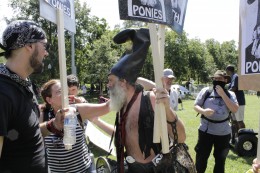
Within minutes of arriving at the smattering of fifty-odd tents in Marshall Park, the small, verdant park across from our hotel, I had met up with one of the Original Occupiers, but had also felt the first rumblings of trouble coming from deep within that unwashed, primal heart of Tent City.
Aaron Black is a diminutive man who projects at once a deep-seated rage against a government he sees as looking out only for the financial elite; but also a very clear notion that one party is a lot better for him and his country than the other.
His inside out shirt and faded Mets cap pulled low seemed an embrace of the counterculture vibe that screeches and rattles your bones as you walk among the tents. Yet Black was somehow out of place. His lines were so perfect as to appear almost scripted; his persona one of concerted non-conformism—an odd juxtaposition to the outcast status that seems to have been fate to so many in Tent City. It was as if a Hollywood costume designer had built a wardrobe based on what they thought a protester would look like.
Many said he was a member of the 200-strong group that originally occupied Wall Street. This claim appears to be true, as he appears in a story from November of last year.
But description of Black didn’t stop there. Even as he implied that his interview was reflective of the demonstrators who milled around him, there was a sense among many there that his interests were not, in fact, at all in symphony with theirs.
As I mentioned in my previous post, it was pretty hard to pin down any specific list of demands, problems or solutions that the demonstrators held in common. The one thing most could agree on, though, was that it wasn’t that any one candidate or party was bad—it was that all they cared about was stomping the little man and making their own wallets fatter.
Black, though, was seen as having an agenda. More than once, demonstrators—including some who were there with him in the nascency of the Occupy movement—less than subtly implied that Black was just parroting Democratic Party talking points.
Demonstrator’s who said Black was channeling the Democratic Party were not invariably critical. It was not uncommon for protesters to actually support the idea that the GOP was, in fact, more beholden to the One Percent than its counterpart. “The Lesser Evil” was the begrudging message.
Regardless of how true this is—and, once I started paying attention, I did hear a lot of the same refrains about women’s health, Obamacare and the heinousness of the the opposite ticket that’s repeated at virtually every Party function—the number of times I heard the charge levelled at Black called to mind several things.
First, that Black had allowed personal belief trump the free-for all bashing of all contemporary politicians and politics. One protester recounted how Black had, just a few hours after arriving, attempted to remove a couple of signs hung up around Tent City because they didn’t reflect what “he believed.”
Occupy has been an enigma in a lot of ways: it is leaderless, platform-less, and an institutionalized rendezvous point for the tired, the poor and huddled masses.
Movements without leaders, though, are weak in a few ways. One, they open themselves up to pseudo-representatives—those who claim to speak for the masses, and whose misrepresentations are discovered only after the fact…after they’ve already been promoted by the media as leaders.
Two, without a leader or any sort of hierarchy, no “movement” can exist in any substantive way. Tent City embodies this. The demonstrators may be united in knowing something is wrong with this country, but beyond that are an ideological pastiche.
Ideological diversity isn’t an inherently bad thing. But when you’re trying to change anything—especially something on as large a scale as the United States, it helps to be seen as a unified movement advocating concrete change. Tent City was instead filled with the semi to uninformed; to rebels without causes, wanting to resist something, but without really knowing what was being resisted. Maybe it was drones, maybe it was the president, maybe it was presidency as an institution (as one activist claimed).
The Movement is to me a teenage boy with ADD and ED—wanting something to be aroused by, but so plagued by distraction as to be rendered totally impotent.
Strong leadership always has its problems—leaders aren’t the sum of our every opinion; they are the best vehicle for delivering our overarching message.
Aaron Black has, by virtue of his time with Occupy and his relative ability to articulate a message, found himself in the role of ad hoc leader. But he is facing something resembling a crisis of confidence, as paradoxical as that may seem in a “leaderless” movement.
This lack of confidence shows in the numbers present at Tent City. When I was there at around 11:30 AM, there were less than 100 people around; it looked like there were enough tents for maybe 150.
At Frazier Park, Vermin Supreme and others espousing similar shenanigans outshouted, if not outnumbered the immigrant, union and other entrenched groups. But sheer number and spirit were much higher. It, too, was a rancid mess, but the sense of frustration—of anger at the emergence of a partisan element within the Movement, was absent.


